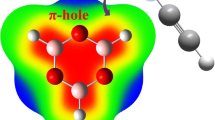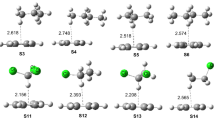Abstract
The intermolecular interactions between the heavy alkenes H2Si = TH2 (T = C, Si, Ge, Sn, Pb) and C2H2 have been calculated at the CCSD(T)/aug-cc-pVTZ//MP2/aug-cc-pVDZ level, and the nature of these complexes has been investigated by natural bond orbital. The four types (type-A, type-B, type-C and type-D) of complexes can be located for H2Si = TH2···C2H2 system. The complexes involving H2Si = TH2···C2F2 and H2Si = TH2···C2(CN)2 have also been examined to explore the substituent effects. Some complexes which are stable for H2Si = TH2···C2H2 system become unstable for H2Si = TH2···C2F2 or H2Si = TH2···C2(CN)2 system, while other complexes which are unstable for H2Si = TH2···C2H2 system become stable for H2Si = TH2···C2F2 or H2Si = TH2···C2(CN)2 system.





Similar content being viewed by others
Data availability
All data generated or analysed during this study are included in this published article.
References
Wheeler SE, Seguin TJ, Guan Y, Doney AC (2016) Noncovalent interactions in organocatalysis and the prospect of computational catalyst design. Acc. Chem. Res 49:1061–1069
Vallavoju N, Sivaguru J (2014) Supramolecular photocatalysis: combining confinement and non-covalent interactions to control light initiated reactions. Chem. Soc. Rev 43:4084–4101
Georgakilas V, Tiwari JN, Kemp KC, Perman JA, Bourlinos AB, Kim KS, Zboril R (2016) Noncovalent functionalization of graphene and graphene oxide for energy materials, biosensing, catalytic, and biomedical applications. Chem. Rev 116:5464–5519
Scheiner S (1997) Hydrogen bonding. a theoretical perspective. Oxford University Press, New York
Politzer P, Lane P, Concha MC, Ma Y, Murray JS (2007) An overview of halogen bonding. J. Mol. Model 13:305–311
Politzer P, Murray JS, Clark T (2010) Halogen bonding: an electrostatically-driven highly directional noncovalent interaction. Phys. Chem. Chem. Phys 12:7748–7757
Sarwar MG, Dragisic B, Sagoo S, Taylor MS (2010) A tridentate halogen-bonding receptor for tight binding of halide anions. Angew. Chem. Int. Ed 49:1674–1677
Hernandes MZ, Cavalcanti SMT, Moreira DRM, de Azevedo Jr WF, Leite ACL (2010) Halogen atoms in the modern medicinal chemistry: hints for the drug design. Curr. Drug Targets 11:303–314
Metrangolo P, Meyer F, Pilati T, Resnati G, Terraneo G (2008) Halogen bonding in supramolecular chemistry. Angew. Chem. Int. Ed 47:6114–6127
Clark T, Hennemann M, Murray JS, Politzer P (2007) Halogen bonding: the sigma-hole. Proceedings of “Modeling interactions in biomolecules II”, Prague, September 5th–9th, 2005. J. Mol. Model 13:291–296
Murray JS, Lane P, Clark T, Riley KE, Politzer P (2012) σ-Holes, π-holes and electrostatically-driven interactions. J. Mol. Model 18:541–548
Bauzá A, Mooibroek TJ, Frontera A (2013) Tetrel-bonding interaction: rediscovered supramolecular force? Angew. Chem. Int. Ed 52:12317–12321
Chehayber JM, Nagy ST, Lin CS (1984) Abinitio studies of complexes between SiF4 and ammonia. Can. J. Chem 62:27–31
Bundhun A, Ramasami P, Murray JS, Politzer P (2013) Trends in σ-hole strengths and interactions of F3MX molecules (M = C, Si, Ge and X = F, Cl, Br, I). J. Mol. Model 19:2739–2746
Grabowski SJ (2014) Tetrel bond-σ-hole bond as a preliminary stage of the SN2 reaction. Phys. Chem. Chem. Phys 16:1824–1834
Grabowski SJ (2018) Tetrel bonds with π-electrons acting as Lewis bases—theoretical results and experimental evidences. Molecules 23:1183
Thomas SP, Pavan MS, Row TNG (2014) Experimental evidence for ‘carbon bonding’ in the solid state from charge density analysis. Chem. Commun 50:49–51
McDowell SAC, Joseph JA (2014) The effect of atomic ions on model σ-hole bonded complexes of AH3Y (A = C, Si, Ge; Y = F, Cl, Br). Phys. Chem. Chem. Phys 16:10854–10860
Mani D, Arunan E (2014) The X-C···π (X = F, Cl, Br, CN) carbon bond. J. Phys. Chem. A 118:10081–10089
Southern SA, Bryce DL (2015) NMR investigations of noncovalent carbon Tetrel bonds. Computational assessment and initial experimental observation. J. Phys. Chem. A 119:11891–11899
Scheiner S (2015) Comparison of CH···O, SH···O, Chalcogen, and Tetrel bonds formed by neutral and cationic sulfur-containing compounds. J. Phys. Chem. A 119:9189–9199
Azofra LM, Scheiner S (2015) Tetrel, chalcogen, and CH···O hydrogen bonds in complexes pairing carbonyl-containing molecules with 1, 2, and 3 molecules of CO2. J. Chem. Phys 142:034307
Bauzá A, Mooibroek TJ, Frontera A (2016) Tetrel bonding interactions. Chem. Rec 16:473–487
Bauzá A, Frontera A, Mooibroek TJ (2016) 1,1,2,2-Tetracyanocyclopropane (TCCP) as supramolecular synthon. Phys. Chem. Chem. Phys 18:1693–1698
Liu MX, Li QZ, Li WZ, Cheng JB (2017) Carbene tetrel-bonded complexes. Struct. Chem 28:823–831
Liu MX, Li QZ, Cheng JB, Li WZ, Li HB (2016) Tetrel bond of pseudohalide anions with XH3F (X = C, Si, Ge, and Sn) and its role in SN2 reaction. J. Chem. Phys 145:224310
Bene JED, Alkorta I, Elguero J (2017) Carbon-carbon bonding between nitrogen heterocyclic Carbenes and CO2. J. Phys. Chem. A 121:8136–8146
Liu MX, Li QZ, Scheiner S (2017) Comparison of tetrel bonds in neutral and protonated complexes of pyridineTF3 and furanTF3 (T = C, Si, and Ge) with NH3. Phys. Chem. Chem. Phys 19:5550–5559
Legon AC (2017) Tetrel, pnictogen and chalcogen bonds identified in the gas phase before they had names: a systematic look at non-covalent interactions. Phys. Chem. Chem. Phys 19:14884–14896
Scheiner S (2018) Comparison of various means of evaluating molecular electrostatic potentials for noncovalent interactions. J. Comput. Chem 39:500–510
Zierkiewicz W, Michalczyk M, Scheiner S (2018) Implications of monomer deformation for tetrel and pnicogen bonds. Phys. Chem. Chem. Phys 20:8832–8841
Liu MX, Yang L, Li QZ, Li WZ, Cheng JB, Xiao B, Yu XF (2016) Modulating the strength of tetrel bonding through beryllium bonding. J. Mol. Model 22:192
McDowell SAC (2014) Sigma-hole cooperativity in anionic [FX···CH3···YF]− (X, Y = Cl, Br) complexes. Chem. Phys. Lett 598:1–4
Esrafili MD, Mohammadirad N, Solimannejad M (2015) Tetrel bond cooperativity in open-chain (CH3CN)n and (CH3NC)n clusters (n = 2–7): an ab initio study. Chem. Phys. Lett 628:16–20
Solimannejad M, Orojloo M, Amani S (2015) Effect of cooperativity in lithium bonding on the strength of halogen bonding and tetrel bonding: (LiCN)n···ClYF3 and (LiCN)n···YF3Cl (Y = C, Si and n = 1-5) complexes as a working model. J. Mol. Model 21:183
Yourdkhani S, Korona T, Hadipour NL (2015) Interplay between tetrel and triel bonds in RC6H4CN···MF3CN···BX3 complexes: a combined symmetry-adapted perturbation theory, Møller-Plesset, and quantum theory of atoms-in-molecules study. J. Comput Chem. 36:2412–2428
Marín-Luna M, Alkorta I, Elguero J (2016) Cooperativity in Tetrel bonds. J. Phys. Chem. A 120:648–656
Esrafili MD, Mohammadian-Sabet F (2016) Cooperativity of tetrel bonds tuned by substituent effects. Mol. Phys 114:1528–1538
Rezaei Z, Solimannejad M, Esrafili MD (2015) Interplay between hydrogen bond and single-electron tetrel bond: H3C···COX2···HY and H3C···CSX2···HY (X = F, cl; Y = CN, NC) complexes as a working model. Comput. Theor. Chem 1074:101–106
Xu HL, Cheng JB, Yang X, Liu ZB, Xiao B, Li QZ (2017) Interplay between the σ-tetrel bond and σ-halogen bond in PhSiF3···4-iodopyridine···N-base. RSC Adv. 7:21713–21720
Li W, Zeng Y, Li X, Sun Z, Meng L (2016) Insight into the pseudo π-hole interactions in the M3H6(NCF)n (M = C, Si, Ge, Sn, Pb; n = 1, 2, 3) complexes. Phys. Chem. Chem. Phys 18:24672–24680
Chen YS, Yao LF, Wang F (2019) Synergistic and antagonistic interplay between tetrel bond and pnicogen bond in complexes involving ring compounds. J. Mol. Model 25:351
Quiñonero D (2017) Sigma-hole carbon-bonding interactions in carbon–carbon double bonds: an unnoticed contact. Phys. Chem. Chem. Phys 19:15530–15540
Remyaa K, Suresh CH (2015) Intermolecular carbon–carbon, nitrogen–nitrogen and oxygen–oxygen non-covalent bonding in dipolar molecules. Phys. Chem. Chem. Phys 17:18380–18392
Varadwaj PR, Varadwaja A, Jin BY (2014) Significant evidence of C···O and C···C long-range contacts in several heterodimeric complexes of CO with CH3–X, should one refer to them as carbon and dicarbon bonds! Phys. Chem. Chem. Phys 16:17238–17252
Alkorta I, Rozas I, Elguero J (2001) Molecular complexes between silicon derivatives and electron-rich groups. J. Phys. Chem. A 105:743–749
Scheiner S (2020) The ditetrel bond noncovalent bond between neutral tetrel atoms. Phys. Chem. Chem. Phys 22:16606–16614
Sethio D, Oliveira V, Kraka E (2018) Quantitative assessment of tetrel bonding utilizing vibrational spectroscopy. Molecules 23:2763
Wei YX, Li QZ, Scheiner S (2018) The π-tetrel bond and its influence on hydrogen bonding and proton transfer. ChemPhysChem 19:736–743
Li QZ, Guo X, Yang X, Li WZ, Cheng JB, Li HB (2014) A σ-hole interaction with radical species as electron donors: does single-electron tetrel bonding exist? Phys. Chem. Chem. Phys 16:11617–11625
Zierkiewicz W, Michalczyk M, Scheiner S (2018) Comparison between Tetrel bonded complexes stabilized by σ and π hole interactions. Molecules 23:1416
Chen Y, Wang F (2020) Intermolecular interactions involving heavy alkenes H2Si=TH2 (T = C, Si, Ge, Sn, Pb) with H2O and HCl: tetrel bond and hydrogen bond. ACS Omega 5:30210–30225
Frisch MJ, Trucks GW, Schlegel HB, Scuseria GE, Robb MA, Cheeseman JR, Scalmani G, Barone V, Petersson GA, Nakatsuji H, Li X, Caricato M, Marenich AV, Bloino J, Janesko BG, Gomperts R, Mennucci B, Hratchian HP, Ortiz JV, Izmaylov AF, Sonnenberg JL, Williams FD, Lipparini F, Egidi F, Goings J, Peng B, Petrone A, Henderson T, Ranasinghe D, Zakrzewski VG, Gao J, Rega N, Zheng G, Liang W, Hada M, Ehara M, Toyota K, Fukuda R, Hasegawa J, Ishida M, Nakajima T, Honda Y, Kitao O, Nakai H, Vreven T, Throssell K, Montgomery Jr JA, Peralta JE, Ogliaro F, Bearpark MJ, Heyd JJ, Brothers EN, Kudin KN, Staroverov VN, Keith TA, Kobayashi R, Normand J, Raghavachari K, Rendell AP, Burant JC, Iyengar SS, Tomasi J, Cossi M, Millam JM, Klene M, Adamo C, Cammi R, Ochterski JW, Martin RL, Morokuma K, Farkas O, Foresman JB, Fox DJ (2013) Gaussian 09, Revision D.01. Gaussian, Inc., Wallingford CT
Feller D (1996) The role of databases in support of computational chemistry calculations. J. Comput. Chem 17:1571–1586
Boys SF, Bernardi F (1970) The calculation of small molecular interactions by the differences of separate total energies. Some procedures with reduced errors. Mol. Phys 19:553–566
Lu T, Chen FW (2012) Multiwfn: a multifunctional wavefunction analyzer. J. Comput. Chem 33:580–592
Reed AE, Curtiss LA, Weinhold F (1988) Intermolecular interactions from a natural bond orbital, donor-acceptor viewpoint. Chem. Rev 88:899–926
Code availability
N/A.
Funding
This work was supported by the Scientific Research Funds from the Educational Department of Yunnan Province, China, grant nos. 2015Y434 and 2020J0634.
Author information
Authors and Affiliations
Contributions
Yishan Chen: Investigation, Conceptualization, Writing–original draft. Lifeng Yao: Writing–review and editing. Fan Wang: Resources, Supervision.
Corresponding author
Ethics declarations
Conflict of interest
The authors declare no competing interests.
Additional information
Publisher’s note
Springer Nature remains neutral with regard to jurisdictional claims in published maps and institutional affiliations.
Rights and permissions
About this article
Cite this article
Chen, Y., Yao, L. & Wang, F. Intermolecular interactions between the heavy alkenes H2Si = TH2 (T = C, Si, Ge, Sn, Pb) and acetylene. J Mol Model 27, 110 (2021). https://doi.org/10.1007/s00894-021-04738-9
Received:
Accepted:
Published:
DOI: https://doi.org/10.1007/s00894-021-04738-9




